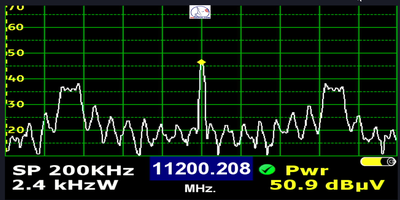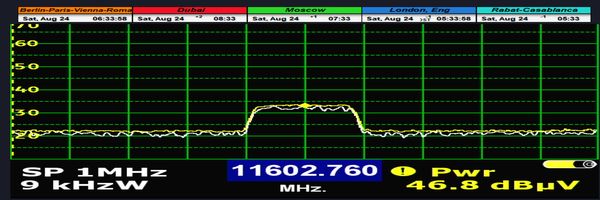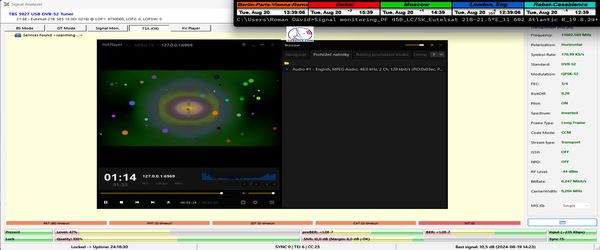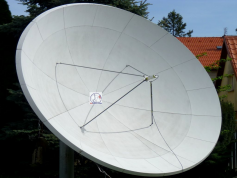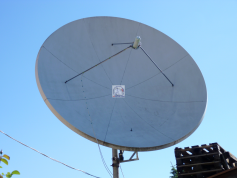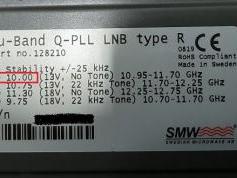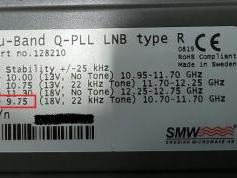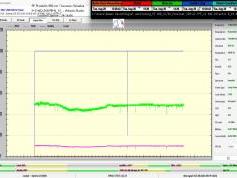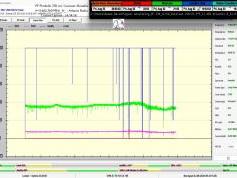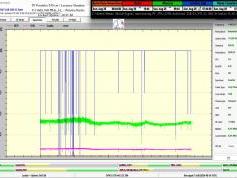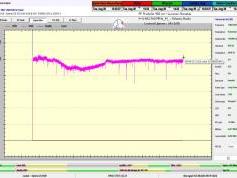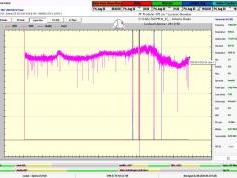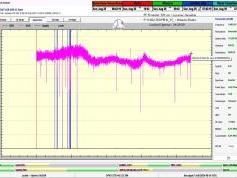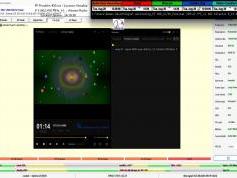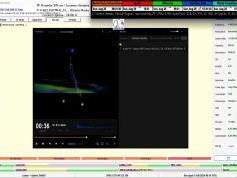Low Symbol Rates (SR) in the practice of satellite reception
Niedrige Symbolraten (SR) in der Praxis des Satellitenempfangs
Nízke Symbolové rýchlosti (SR) v praxi satelitného príjmu

Low Symbol Rates (SR) in practice of satellite reception
Eutelsat 21B at 21.5°E-Western : PF Prodelin 450 & PF Prodelin 370
11 602,760 MHz_H_SR=171 ksym/s : Atlantic Radio
( Update date: 28.8.2024 )
>Eutelsat 21B at 21.5°E_Low Symbol Rate>SR=171 ksym/s in satellite reception practice & Atlantic Radio <
and the resulting continuity of lock and quality on the carrier with an applied symbol rate parameter of SR=171 ksym/s at the output of a symmetric Prodelin
reflector with a diameter of d=370 cm.
und dem resultierenden Verlauf der Kontinuität des Lock- und Qualitätsmerkmals auf dem Träger mit einem angewendeten Symbolratenparameter
von SR=171 ksym/s am Ausgang eines symmetrischen Prodelin-Reflektors mit einem Durchmesser von d=370 cm.
kontinuity Lock-u a kvality na nosnej s aplikovaným parametrom symbolovej rýchlosti SR=171 ksym/s na výstupe zo symetrického reflektora Prodelin s priemerom
d=370 cm
►►Eutelsat 21B at 21.5°E-Western : Low symbol rates (SR) in satellite reception practice
Installed symmetric reflectors and the diameter of their effective area : D=370 & 450 cm
R1 R2
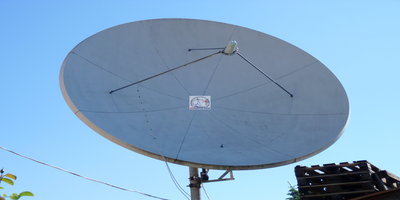
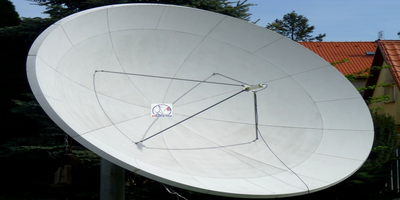
►Signálny reťazec je tvorený / The signal chain consists of the following components : Prodelin 450/370 cm
that minimize any wave reflections,maximize its signal permeability,with high conductivity of the tube, and a specific focus on implementing the waveguide
flange > SMW PLL LNB 9.75 GHz +/- 10 kHz
PF Prodelin 370 cm > Primary feedhorn placed in the manual SKEW rotation mechanism > OMT type ESA-1212-X/1 > LNB SMW Q-PLL type R, LOF stability +/- 25 kHz
Drehbank), mit physikalischen Modifikationen, die jegliche Wellenreflexionen minimieren, die Signalpermeabilität maximieren, mit hoher Leitfähigkeit des Rohrs
und einem speziellen Fokus auf die Implementierung der Wellenleiterflansche > SMW PLL LNB 9.75 GHz _ +/- 10 kHz
►►Eutelsat 21B at 21.5°E-Western : Beacon frequency / TT&C
Eutelsat 21B : BEACON FREQUENCY > f=12 500.5 MHz_V
- šírka rozmietania SP=100 kHz -
- hodnota vstupných filtrov RBW= 1 W/kHz + 600 W/Hz -
► týmto som dokázal že mnou navrhnutý signálny reťazec generuje frekvenčné údaje s vysokou presnosťou (na jednotky tisícin-1/1000 z jednotky 1 MHz)
čiže publikované údaje sú hodnoverné a relevantné pre vedecko-výskumnú prácu v oblasti vlnovej fyziky
►I have demonstrated through this that the signal chain I have designed generates frequency data with high precision
(to the order of one-thousandth, 1/1000, of 1 MHz). Therefore, the published data is reliable and relevant.
Eutelsat 21B : TT&C > 11 699,80 MHz_H / 11 200,20 MHz_H
►►Eutelsat 21B at 21.5°E-Western-spectrum analysis : 11 602,760 MHz_H - Atlantic Radio
C1_11 599,250 MHz : Chada FM
C2_11 599,530 MHz : Medina FM
C3_11 599,760 MHz : MED Radio
C4_Carrier width/Trägerbreite : 204 kHz
SPAN=1 MHz : 11 599,250>11 599,530>11 599,760 MHz >11 602,760 MHz
►►Eutelsat 21B at 21.5°E-Western-11 602,760 MHz : Frequency OFFSET or evidence of a deviation around 190 kHz between
the lock frequency and the actual frequency
and clearly demonstrated on this radio carrier with an ultra-narrow carrier bandwidth.
gilt und eindeutig auf diesem Funkträger mit einer extrem schmalen Trägerbandbreite demonstriert wird.
►Dôkaz o frekvenčnej odchýlke alebo podladení od 187 do 201 kHz,ktoré platí pre HW/SW konfiguráciu TBS 5927 & EBSpro a je jasne demonštrovaná na každej
TBS 5927/EBSpro : Locking frequency 11 602.569>11 602,571 and Downlink frequency : 11 602.760 MHz
Frequency OFFSET : minus 189-191 kHz
►►Eutelsat 21B-11 602,760 MHz : The relationship between the selection of the oscillator in a four-oscillator LNB and the resulting continuity
of lock and quality on the carrier with an applied symbol rate parameter of SR=171 ksym/s
and quality on the carrier with an applied symbol rate parameter of SR=171 ksym/s at the output of a symmetric Prodelin reflector with a diameter of d=370 cm.
der Kontinuität des Lock- und Qualitätsmerkmals auf dem Träger mit einem angewendeten Symbolratenparameter von SR=171 ksym/s am Ausgang
eines symmetrischen Prodelin-Reflektors mit einem Durchmesser von d=370 cm.
poveternostných podmienkach jasnej oblohy som vykonal 2 porovnávacie testy s dvoma rôznymi oscilátormi LOF1=10 GHz a LOF2=9.750 GHz za účelom
skúmania vzťahu medzi výslednou kvalitou príjmu a možnosťou dosiahnutia kontinuálneho priebehu Locku nosnej.
s LOF2=9.750 GHz o 0,7-0,8 dB alebo 7,4 dB s LOF2 < 8,1 dB-8,2 dB s LOF1, ani na jednom z nich som nedosiahol stabilitu príjmu na 100% a počas 24 hodín
dochádzalo,typicky 8-10x k výpadkom v spojitosti priebehu Locku,čo môžem percentuálne kvantifikovať ako degradovanú stabilitu príjmu na 99,05% s LOF1
a 99,87 % s LOF2 keď som s LOF1 celkovo 4x zaznamenal výpadky v trvaní okolo 40 sekúnd a jeden dlhý výpadok v trvaní 780 sekúnd,čo je v súčte
až 820 sekúnd z dôvodu že obnova Locku po jeho strate,alebo výpadku nie je okamžitá a trvá typicky až okolo 5 sekúnd pri danej hodnote SR=171 ksym/s.
Pradoxne som dokázateľne dosiahol vyššiu stabilitu príjmu s LOF2=9.75 GHz ako s LOF1 aj napriek celkovo vyššej špičke kvality SNR
o približne +0,7-0,8 dB s LOF1=10.00 GHz.
v kontinuite priebehu Locku,inak povedané dátový tok rádio streamu zamrzne.Dočasné poklesy modrého priebehu kvality Q v percentách na úroveň napríklad
40 alebo 20% má taktiež dosah alebo vplyv na plynulosť toku dát/streamu,ale k výpadku v kontinuite nedochádza a je to takzvaný hraničný alebo limitný stav príjmu
pri minimálnej signálnej rezerve v signálnom reťazci.
►Methodological procedure of measurements: In a uniform time unit of signal monitoring or in a visualized form of evidence, t=24 hours, and under comparable
weather conditions of a clear sky, I conducted 2 comparative tests with two different oscillators, LOF1=10.00 GHz and LOF2=9.75 GHz, in order to examine the
relationship between the resulting reception quality and the possibility of achieving a continuous lock on the carrier signal.
►Classification of the achieved results: Despite the fact that the peak quality achieved with the applied oscillator LOF1=10.00 GHz exceeded the peak quality of
LOF2=9.750 GHz by 0.7-0.8 dB, or 7.4 dB with LOF2 < 8.1 dB-8.2 dB with LOF1, I did not achieve 100% reception stability with either oscillator, and during
the 24-hour period, there were typically 8-10 dropouts in the continuity of the Lock, which I can quantify as a degraded reception stability of 99.05% with LOF1
and 99.87% with LOF2. With LOF1, I recorded a total of 4 dropouts lasting around 40 seconds each and one long dropout lasting 780 seconds, amounting
to 820 seconds in total, due to the fact that the restoration of the Lock after its loss or dropout is not instantaneous and typically takes around
5 seconds at the given SR=171 ksym/s. Paradoxically, I achieved higher reception stability with LOF2=9.75 GHz than with LOF1,
despite the overall higher SNR peak quality by approximately 0.7-0.8 dB with LOF1=10.00 GHz.
You may ask how a dropout in the continuity of the Lock is visualized on the signal monitoring graph? The answer: When the blue quality curve
(which drops to 0%) and the red BER error rate curve merge on the X-axis, an immediate dropout in the continuity of the Lock occurs,
meaning the radio stream data flow freezes. Temporary drops in the blue quality curve (Q) in percentages, for example to levels of 40% or 20%,
also have an impact on the smoothness of the data/stream flow, but do not cause a dropout in continuity. This is known as the threshold
or limit state of reception with minimal signal reserve in the signal chain.
►Methodisches Vorgehen bei den Messungen: In einer einheitlichen Zeiteinheit des Signalmonitorings oder in visualisierter Form des Nachweises, t=24 Stunden,
und unter vergleichbaren Wetterbedingungen eines klaren Himmels führte ich zwei Vergleichstests mit zwei verschiedenen Oszillatoren, LOF1=10,00 GHz
und LOF2=9,75 GHz, durch, um die Beziehung zwischen der resultierenden Empfangsqualität und der Möglichkeit eines kontinuierlichen Lock-Verlaufs auf dem
Trägersignal zu untersuchen.
►Klassifizierung der erzielten Ergebnisse: Trotz der Tatsache, dass die erreichte Spitzenqualität mit dem angewendeten Oszillator LOF1=10,00 GHz die
Spitzenqualität von LOF2=9,750 GHz um 0,7-0,8 dB oder 7,4 dB mit LOF2 < 8,1 dB-8,2 dB mit LOF1 übertraf, erreichte ich bei keinem der Oszillatoren
eine Empfangsstabilität von 100%, und im Verlauf von 24 Stunden kam es typischerweise 8-10 Mal zu Ausfällen in der Kontinuität des Locks, was ich als eine
degradierte Empfangsstabilität von 99,05% mit LOF1 und 99,87% mit LOF2 quantifizieren kann. Mit LOF1 habe ich insgesamt 4 Ausfälle mit einer Dauer
von etwa 40 Sekunden und einen langen Ausfall mit einer Dauer von 780 Sekunden aufgezeichnet, was insgesamt 820 Sekunden ergibt, da die Wiederherstellung
des Locks nach seinem Verlust oder Ausfall nicht sofort erfolgt und typischerweise etwa 5 Sekunden bei der gegebenen SR=171 ksym/s dauert.
Paradoxerweise habe ich eine höhere Empfangsstabilität mit LOF2=9,75 GHz als mit LOF1 erreicht, obwohl die insgesamt höhere Spitzenqualität
des SNR mit LOF1=10,00 GHz um etwa 0,7-0,8 dB höher war. Sie fragen sich vielleicht, wie sich ein Ausfall in der Kontinuität des Locks im
Signalüberwachungsdiagramm visualisiert? Die Antwort: Wenn die blaue Qualitätskurve (die auf 0% fällt) und die rote BER-Fehlerrate-Kurve auf der
X-Achse zusammenfallen, kommt es zu einem sofortigen Ausfall in der Kontinuität des Locks, anders gesagt, der Datenstrom des Radiostreams friert ein.
Vorübergehende Einbrüche der blauen Qualitätskurve (Q) in Prozent, zum Beispiel auf 40% oder 20%, haben ebenfalls einen Einfluss auf die
Fließfähigkeit des Datenstroms/Streams, führen jedoch nicht zu einem Ausfall der Kontinuität. Dies wird als Schwellen- oder Grenzzustand des
Empfangs bei minimaler Signalreserve in der Signalkette bezeichnet.
PF 450 PF 370 PF 370
LNB SMW PLL 9.75 GHz ± 10 kHz LNB SMW Q-PLL-R +10.00 GHz ± 25 kHz SMW Q-PLL-R+9.75 GHz ± 25 kHz
SNR peak =10,5-10,8 dB SNR peak=8,1-8,2 dB SNR peak=7,4-7,5 dB
Proven stability : 100% Proven stability : 99,05% Proven stability : 99,87%
Link to the news / Link zur Neuigkeit : https://www.dxsatcs.com/content/eutelsat-21b-low-symbol-rate-sr-atlantic-radio



